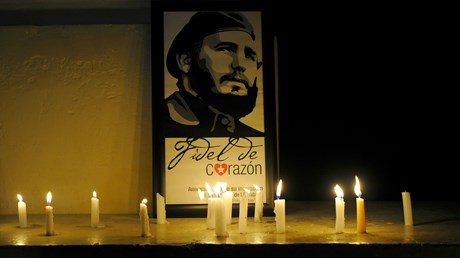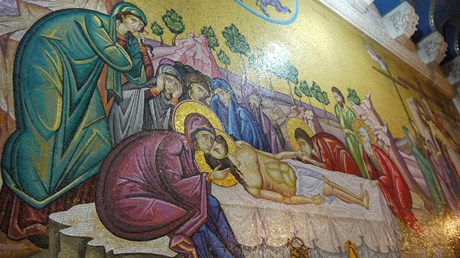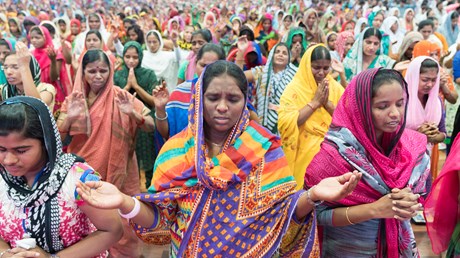Wednesday, 30 November 2016
John 1:1-2, 14
from
https://www.biblegateway.com/passage/?version=NIV&search=John%201:1-2,%2014
On theists believing ridiculous, unscientific things, and Terror Management Theory
Over at another post of mine, when I originally posted it some time back, we had been discussing whether religion can and should be destroyed. During that conversation, the idea came up that Christians, in all probability, hold more ridiculous beliefs that are unscientific in nature; and also arose the connected idea that Christians, in a generalistic [Read More...]
The post On theists believing ridiculous, unscientific things, and Terror Management Theory appeared first on A Tippling Philosopher.
from
http://www.patheos.com/blogs/tippling/2016/11/30/theists-believing-ridiculous-unscientific-things-terror-management-theory/
How Fidel Castro’s Death Will Affect Cuba’s Christian Revival
It won’t. And that’s (mostly) a good thing.

The remains of Fidel Castro are being displayed in Havana as part of Cuba’s nine days of official mourning for the deceased dictator. Many world leaders will not attend the funeral next week for the man who raised literacy rates but kept a rigid grasp on civil rights.
For Cuban Christians, his death isn’t likely to be a sea change in how the island nation’s Communist government approaches religion.
Like most Cubans, Castro himself was raised Catholic, educated by Jesuit priests as a child. He rejected his faith during the 1959 revolution, after the church rejected his movement toward atheism and socialism. Priests were killed and deported, while Christians (and other groups) were discriminated against and banned from joining the Communist Party.
But Castro—and his brother, current ruler Raúl—softened with time. Some credit the Catholic Church and its popes with influencing Cuba’s slow turn from Marxism.
They were also good for religious holidays. Pope John Paul II visited the country in 1998; the next day, Castro reinstated Christmas. In 2012, Pope Benedict visited; soon after, the government allowed Good Friday observances.
This year, Cuba was the site of a historic step toward religious reconciliation: Pope Francis sat down with Russian Orthodox Patriarch Kirill in Havana in the first meeting between Roman Catholic and Eastern Orthodox heavyweights since the Christian church split into West and East in 1054.
Even though Castro’s last writings recalled the stories of Adam and Eve, Noah and the ark, and God’s provision of manna, the level of his faith remains a mystery, reported Crux.
Despite the tension between church and state in Cuba, Christianity there has been undergoing ...
from
http://feeds.christianitytoday.com/~r/christianitytoday/ctmag/~3/h7zdTP4dbpw/how-fidel-castro-death-will-affect-cuban-christians-revival.html
News: Why Two Tombs Compete for Jesus’ Burial
Historic renovations at the Church of the Holy Sepulchre won’t change some Protestants’ preference for the Garden Tomb.

Beneath layers of ancient marble, renovators at the Church of the Holy Sepulchre in Jerusalem say they have found what may be the limestone bench where the body of Jesus was laid after his crucifixion.
For the first time in half a millennium, church officials have allowed access to a tomb even more famous than that of “King Tut,” the Egyptian pharaoh Tutankhamun.
However, they can’t say for sure that it is the right tomb.
The official purpose of the historic project is to rebuild the Edicule, the shrine in the middle of the church rotunda which encloses the tomb. Built in the early 19th century over previous constructions, the shrine was in danger of collapse and barely held together by iron girders added decades later.
Beginning October 26 and working nonstop for 60 hours, a team from the National Technical University of Athens removed marble coverings and layers of fill and debris, before finally reaching the revered limestone level at the base of the tomb. They also discovered, surprisingly, that the limestone walls of the tomb were somewhat intact beneath the layer of marble.
“We can’t say 100 percent, but it appears to be visible proof that the location of the tomb has not shifted through time—something that scientists and historians have wondered for decades,” said Fredrik Hiebert, archaeologist-in-residence for National Geographic, which documented the discovery.
But why is this tomb revered, and not one of the other tombs archaeologists have found in the area, which was a quarry before it was converted to a burial place in the first century?
The tradition associated with the Church of the Holy Sepulchre goes back to the fourth century when Helena, the Christian mother of the emperor ...
from
http://feeds.christianitytoday.com/~r/christianitytoday/ctmag/~3/g0RXlS_PYNo/why-two-tombs-compete-jesus-burial-holy-sepulchre-garden.html
News: Why Two Tombs Compete for Jesus’ Burial Place
Historic renovations at the Church of the Holy Sepulchre won’t change some Protestants’ preference for the Garden Tomb.

Beneath layers of ancient marble, renovators at the Church of the Holy Sepulchre in Jerusalem say they have found what may be the limestone bench where the body of Jesus was laid after his crucifixion.
For the first time in half a millennium, church officials have allowed access to a tomb even more famous than that of “King Tut,” the Egyptian pharaoh Tutankhamun.
However, they can’t say for sure that it is the right tomb.
The official purpose of the historic project is to rebuild the Edicule, the shrine in the middle of the church rotunda which encloses the tomb. Built in the early 19th century over previous constructions, the shrine was in danger of collapse and barely held together by iron girders added decades later.
Beginning October 26 and working nonstop for 60 hours, a team from the National Technical University of Athens removed marble coverings and layers of fill and debris, before finally reaching the revered limestone level at the base of the tomb. They also discovered, surprisingly, that the limestone walls of the tomb were somewhat intact beneath the layer of marble.
“We can’t say 100 percent, but it appears to be visible proof that the location of the tomb has not shifted through time—something that scientists and historians have wondered for decades,” said Fredrik Hiebert, archaeologist-in-residence for National Geographic, which documented the discovery.
But why is this tomb revered, and not one of the other tombs archaeologists have found in the area, which was a quarry before it was converted to a burial place in the first century?
The tradition associated with the Church of the Holy Sepulchre goes back to the fourth century when Helena, the Christian mother of the emperor ...
from
http://feeds.christianitytoday.com/~r/christianitytoday/ctmag/~3/9VXJqMHWGqY/why-two-tombs-compete-for-jesus-burial-place.html
Incredible Indian Christianity: A Special Report on the World’s Most Vibrant Christward Movement
Why it’s the best and worst of times for India’s burgeoning churches.

The world’s most unexpected megachurch pastor might be an illiterate, barefoot father of five.
Bhagwana Lal grows maize and raises goats on a hilltop in Rajasthan, India’s largest state, famous for its supply of marble that graces the Taj Mahal. He belongs to the tribals: the cultural group below the Dalits, whose members are literally outcasts from India’s caste system (and often called “thumb signers” because of how they vote).
Yet every Sunday, his one-room church, with cheerful blue windows and ceiling fans barely six feet off the ground, pulls in 2,000 people. His indigenous congregation draws from local farmers, whose families’ members take turns attending so that someone is tending the family’s animals. The cracks in the church’s white outer walls are a source of pride: They mark the three times the building has been expanded.
Thousands of colorful flags stream down the sanctuary along the blue beams that support the corrugated metal roof. Their rustling approaches a roar.
When asked the reason for the flags, Lal responds, “For joy!” laughing heartily. The decorations are normally used at weddings. “The same feeling should be inside the church. People should feel this is God’s place.”
Yet consider a contrasting megachurch in southern India. A taxi drives under the shadow of Hyderabad’s four-story elevated train, whose massive support beams are marked with alternating colorful gods and goddesses. The roadside, lined with movie posters and squatter tents, gives way to clusters of large stone elephant-headed gods waiting to be painted with customary bright colors. The taxi turns into a dense traffic jam: a mile-long jumble of buses, motorcycles, ...
from
http://feeds.christianitytoday.com/~r/christianitytoday/ctmag/~3/IRBg2CHTwsM/incredible-india-christianity-special-report-christward-mov.html
Thriving at the Edges of the World
E. Stanley Jones calls us to radical conservatism and a conservative radicalism.

The edges of the world capture our attention. Think of frontiers such as the frozen mountains of Antarctica, the Australian outback, or the Amazon jungle. They are places of great opportunity and, at the same time, filled with unknown threats.
As Americans, we have long been cast in the mold of the pioneer, thriving at the edges. Think of Benjamin Franklin creating the first public library, the Wright brothers taking flight, or innovators such as Bill Gates and Steve Jobs bringing us into the digital age. The interesting thing about the pioneering spirit is that it is equally conservative and progressive in its outlook. “How so?” you say.
Well, first let’s define these terms (as delivered by Google):
Progressive: a person advocating or implementing social reform or new, liberal ideas.
Conservative: a person who is averse to change and holds to traditional values and attitudes, typically in relation to politics.
With these definitions in mind, think about pioneers in innumerable fields who innovated in creative ways. Their drive to come up with new solutions required innovation and progressive approaches. Yet, at the same time, they innovated to conserve their independence, values, and the opportunity to determine their own destiny.
I am sure that not every pioneer felt drawn to each perspective equally, but they both needed to be present to thrive on the edges of the world. It was not possible to affirm only one way of thinking. It was the combination of these two perspectives that made thriving possible. The progressive perspective kept them moving forward into new possibilities, and the conservative perspective kept them grounded in their values. Together, both of these perspectives made these innovators a ...
from
http://feeds.christianitytoday.com/~r/christianitytoday/ctmag/~3/bgOGxI1LYpc/thriving-at-edges-of-world.html
Sibling Rivalry: From Childhood to the Church
Will they—or will we—ever stop fighting?

“Stop it! Don’t touch me!”
“She started it.”
“No, I didn—”
“Yes! You! Did!”
In our Christian subculture, the words “brother” and “sister” tend to conjure up feelings of kinship, intimacy, and loyalty. This made sense to me once. But then I became a parent.
My children—aged 12, 10, and 7—are not unlike most siblings. They have their “We Are the World” moments: those times that melt a parent’s heart and reassure us that there is hope for the future of humanity. Unfortunately, these moments are interrupted by equally frequent moments of rage, selfishness, and aggression. At times, it feels like the majority of my parenting is devoted to brokering peace between warring parties.
Psychology offers us myriad explanations for sibling behavior—everything from birth order to the need to differentiate oneself from the other members of the family. Sometimes this can create a dynamic that an older granny in my church calls “pick and pluck”: that kind of bickering and agitation that seems to exist for the sheer sake of existing. As frustrating as it can be, though, the task of parenting through sibling conflict has changed how I read the New Testament. It’s also changed what I expect as normal from the church.
Brothers and Sisters
Despite the fact that our everyday experiences teach us otherwise, we’re often tempted to sentimentalize family relationships, including the relationships between brothers and sisters. Television series like Parenthood and this year’s breakout hit This Is Us tap into our longing, not only for parental acceptance, but also for that unique bond that forms horizontally between ...
from
http://feeds.christianitytoday.com/~r/christianitytoday/ctmag/~3/FEpR__PMSJM/sibling-rivalry-from-childhood-to-church.html
Tuesday, 29 November 2016
2 Peter 3:10-11
from
https://www.biblegateway.com/passage/?version=NIV&search=2%20Peter%203:10-11
Gender Selection Abortions – Take 3
This is the third and last article in a series on this subject. The previous two are: Gender Selection Abortions Gender Selection Abortions – Take 2 Ask any adamant pro-choicer what they think of a woman who seeks an abortion solely because she has a female fetus, and you will most likely get a look [Read More...]
The post Gender Selection Abortions – Take 3 appeared first on A Tippling Philosopher.
from
http://www.patheos.com/blogs/tippling/2016/11/29/gender-selection-abortions-take-3/
I’m Trying to Forgive Fidel Castro
As the daughter of Cuban refugees, I feel torn between hate and grace.

Last Friday, Fidel Castro passed away. World leaders have responded with a variety of statements. Canadian Prime Minister Justin Trudeau issued a statement about Castro’s death that praised Castro’s love for the Cuban people. President Obama’s statement was somewhat neutral and, instead of condemning the actions of the leader of the Cuban Revolution, focused on restoring the relationship between Cuba and the United States. President-elect Donald Trump issued the most scathing—and dare I say most truthful—statement, saying, “Fidel Castro’s legacy is one of firing squads, theft, unimaginable suffering, poverty, and the denial of fundamental human rights.”
As a first-generation Cuban American and a Christian, my response has come in the form of a question: How do I respond to the death of a man whom I was taught to hate for so long?
When I was a kid, every night before bed, my dad would tell my little sister and me dramatic stories from his life—how he was blacklisted; how he and my mother escaped the island; how they settled as political refugees in the United States. What every story had in common was Castro, the villainous dictator. He was the man who turned their island paradise into a totalitarian hell where personal freedom was hard to come by and everyone but the politically powerful struggled to have enough to eat. We abhorred Castro and joked about how someone with such a lovely name—Fidel means “faithful” in Spanish—could betray his country and kill thousands. Our bedtime ritual was like the Jewish custom at Purim: During the reading of the story of Esther, the mention of Haman’s name brings boos and hisses. There was no room in my heart ...
from
http://feeds.christianitytoday.com/~r/christianitytoday/ctmag/~3/VV80dIaPuwA/im-trying-to-forgive-fidel-castro.html